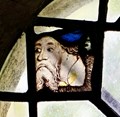Story
St Julittas at Lanteglos by Camelford is a Grade 1 listed Anglican church in regular use. It dates back to the 12th century and the 70 foot tower is said to be 14th century. There were 3 bells in the tower in 1549. In 1783 these were melted down and recast in a field at Helstone by Penningtons and 3 bells added at that time. To cast a bell in those days, it was not unusual to dig a hole near the church and line it with bricks and clay using a bell shaped plug. Then a molten mix of copper and tin 4:1 was poured in and another bell shaped plug inserted. All very basic but these 6 bells are still in the tower.
Two of the original 1549 bells had to be re-cast by Warner and Sons (1883/6) in the field next to Lanteglos churchyard. Warners claim to fame was that they cast the original massive 16 tonne bell for Big Ben. Sadly, it never got hung because it cracked when on display at the base of Big Ben. It had to be melted down by Mears at their Whitechapel Foundry. But after the new bell was hung it also cracked! Both Mears and Warners claimed that the clapper recommended by Dennison, the designer of Big Ben's clock, was too heavy. A big court case followed, but the Mears bell is still in Big ben with the crack!
The heaviest bell at Lanteglos is the Tenor (G sharp) weighing 10cwt, dated 1783. It has the name of a much loved 18th century Rector William Phillips, who carved milestones as a hobby. One of his milestones can still be seen in Trefrew Road, Camelford, dated 1752 with a cross carved on top.
The bells of Lanteglos were used as a testbed for the worlds first ever electronic bell ringing simulator. When talented engineer Peter Cummins retired in the 1970s, he moved to Camelford with his wife Evelyn who then took up handbell ringing. Cummins - a war hero who defused German bombs and mines and later worked with Barnes Wallis at Vickers - decided to use his electronic skills to develop a bell ringing simulator to help his wife practise. This led to the first ever electronic simulator for church bells, developed in the tower at Lanteglos!
The idea was to make it possible to practise ringing with the bell clapper muffled and with the sound produced electronically instead. The big advantage is that a beginner can practise without the neighbourhood hearing all the mistakes. But there was also an advantage for an experienced bell ringer in that the machine could be set to produce the sounds of all the other bells. These electronic bell sounds could be programmed to ring in various methods, rounds, bobs and singles. The person practising could then join in by 'ringing' the bell with the silenced clapper.
The Lanteglos System worked by fixing a small piece of reflective hardboard on the side of bell-rope wheel. This triggered an optical sensor and sent an electronic signal each time it was picked up by the sensor. You can still see the reflective headboard stuck on several of the wheels and some of the tangled of wires are still there, but the rest of the equipment is now preserved in Taylors Foundry Museum in Loughborough. Cummins also installed a ringing system in his loft at home with the bell rope coming down to the hall through the bedroom in a drain pipe. Evelyn, his third wife, must have been a very tolerant lady!
Now we move on to the crumbling windows with high quality medieval stained glass. Quite possibly funded by the Archbishop of Canterbury more than 500 years ago
 Campaign by
Campaign by 